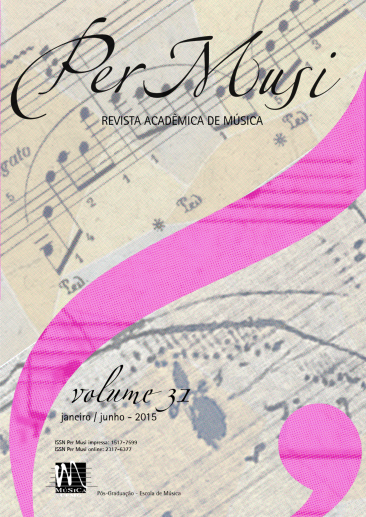Flautas transversais renascentistas
história, construção e experimento com madeiras brasileiras
Palavras-chave:
Flauta transversal renascentista, Música da renascença, Construção de instrumentos musicais, Madeiras brasileiras na luteriaResumo
Originária da flauta transversal alemã do séc. XII, a flauta transversal renascentista, também chamada de traverso, atingiu o ápice de sua popularidade entre os séculos XVI e XVII. Como tantos outros instrumentos musicais acústicos, as técnicas para sua construção e para seleção dos materiais utilizados, em especial das madeiras, são ditadas muito mais pela tradição e por generalizações intuitivas do que por indicações resultantes de pesquisa científica empírica. Este trabalho descreve uma breve história das flautas renascentistas, sua utilização, suas formas de execução e, principalmente, sua construção, a fim de avaliar até que ponto a seleção de materiais é importante para determinar as características qualitativas do instrumento, sendo que para este último ponto, foram utilizadas madeiras nacionais não tradicionais (como imbuia e sucupira), para a confecção, gerando bons exemplares.
Referências
AGRICOLA, Martin. Musica instrumentalis deudsch. RHAU, Georg (ed). Wittemberg: 1529 e 1545.
ARBEAU, Thoinot. Orchesographie. DES PREYZ, Lehan (ed). Lengres: 1589.
ALLAIN-DUPRE, Philippe. Proportions of Renaissance Tenor Flutes and the Relationship of Verona Flutes to Foot-Length Standards. The Galpin Society Journal, v.59, p.21-28, 2006.
______.Renaissance and Early Baroque Flutes: An Update on Surviving Instruments, Pitches and Consort Groupings. The Galpin Society Journal, v.57, p.53-61, 2004.
______.Les flutes de Rafi. Courlay: J. M. Fuzeau, 2000.
ATTAINGNANT, Pierre. Chansons Musicales. Paris: 1533.
BAINES, Anthony. Woodwind instruments and their history. New York: W. W. Norton, 1957.
BENFATTI, Maurício;GODOI, Elena; MAZUROSKI, Arsteu; FERREIRA, Rodrigo Bueno. Cognición y cultura musical: El rol del contexto em El desarrollo Del comportamiento musical. A Contratiempo, v.18, n. 3, p.1-11, 2012.
BRAGARD, Roger; DE HEN, Ferdinand. Musical Instruments in Art and History. New York: The Viking Press, 1968.
BROWN, Howard Mayer. Flute In: The New Grove Dictionary of Music and Musicians. 6ª ed. London: Macmillan, 1980.
BYRNE, Maurice. Instruments by Claude Rafi in the Collection of Manfredo Settala. The Galpin Society Journal, v.18, p.126, 1965.
CARDAN, Jerôme. De musica. Sponius (ed). Lyon: 1546 (publicação póstuma em 1663).
CAZEAUX, Isabelle. French Music in the Fifteenth and Sixteenth Centuries. New York: Praeger Publications, 1975.
CEULEMANS, Anne-Emmanuelle. De la Vièle Médiévale au Violon du XVIIe Siècle. Tournhout: Brespols, 2011.
FLEISCHER, Helmut; ZWICKER, Tilmann. Investigating dead spots of electric guitars. Acta Acustica united with Acustica, v.85, p.128-135, 1999.
______, ______. Mechanical vibrations of electric guitars. Acta Acustica united with Acustica, v.84, p.758-765, 1998.
LEIPP, Émile. Acoustique et musique. Paris: Presses des Mines, 2010.
HELMHOLTZ, Hermann von. On the Sensations of Tone. New York: Dover, 1954.
LORENZI, Harri. Árvores Brasileiras: Manual de Identificação e Cultivo de Plantas Arbóreas Nativas do Brasil, v.1. 5ª ed. Nova Odessa: Instituto Plantarum de Estudos da Flora, 2008.
______. Árvores Brasileiras: Manual de Identificação e Cultivo de Plantas Arbóreas Nativas do Brasil, v. 2. 3ª ed. Nova Odessa: Instituto Plantarum de Estudos da Flora, 2009.
MERSENNE, Marin. Harmonie Universelle. CRAMOISY, Sébastien (ed). Paris: 1636.
PEREIRA, Rodrigo Mateus; LAIBIDA JUNIOR, Albary; FREITAS, Thiago Corrêa de. Sobre o acoplamento corda-corpo em guitarras elétricas e sua relação com o timbre do instrumento. Physicæ, v.9, p.24-29, 2010.
PRAETORIUS, Michael. Syntagma musicum. HOLWEIN, Elias (ed.). Wolfenbüttel, 1619.
PUGLISI, Filadelfio. Flauti traversi rinascimentali in Italia. Firenze: S.P.E.S, 1995.
______. The renaissance flutes of the Biblioteca Capitolare of Verona. The Galpin Society Journal, v.32, p.24-37, 1979.
______. A survey of Renaissance Flutes. The Galpin Society Journal, v. 41, p.67-78, 1988.
RICHTER, Hans Georg. Holz als Rohstoff für den Musikinstrumentenbau. Celle: Moeck, 1988.
ROBINSON, Trevor. The amateur wind instrument maker .Massachusetts: MIT Press,1980.
ROGNONI, Francesco. Selva de varii passaggi. Milão: 1592.
SACHS, Curt. The History of Musical Instruments. New York: W. W. Norton, 1940.
SCHWANKL, Alfred. Welches Holz ist das? Stuttgart: Franckh’sche Verlagshandlung, 1955.
SMITH, Anne. The Renaissance Flute In: The Early Flute de John Slolum. Oxford: Oxford University Press, 1992.
TRICHET, Pierre.Traité des instruments de musique. Paris: 1640.
TRICOU, Georges. Claude Rafi Fleustier Lyonnais. Revue musicale de Lyon, Année I, n.2, p.25-27, 1903.
VAN EYCK, Jacob. Der Fluyten Lust-hof. MATTHYSZ, Paulus (ed). Amsterdam: 1649.
VIRDUNG, Sebastian. Musica getutsch. FURTER, Michael (ed). Bâle: 1511.
VIRGILIANO, Aurelio. Il Dolcimelo. Bolonha: 1590.
WEHR, Nils Joachim; TOMAZELLO FILHO, Mário. Caracterização dos anéis de crescimento de árvores de Araucaria angustfolia (Bert.) O. Ktze, através de microdensitometria de raios X. Scientia Forestalis, v.58, p.161-170, 2000.
ZACCONI, Lodovico. Prattica di musica. PÓLO, Girolamo (ed). Veneza: 1592.
Downloads
Publicado
Edição
Seção
Licença
Copyright (c) 2015 Per Musi

Este trabalho está licenciado sob uma licença Creative Commons Attribution 4.0 International License.

Exceto onde está indicado, o conteúdo neste site está sob uma Licença Creative Commons - Atribuição 4.0 Internacional.












